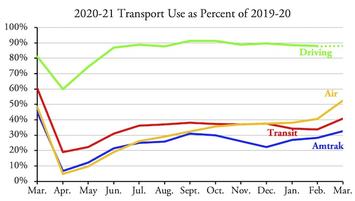
Public transit carried 33 percent fewer riders in March 2021 than in March 2020 and 59 percent fewer than in March 2019, according to data published yesterday by the Federal Transit Administration. Since the pandemic started having an effect on transit in March 2020, we have to go back to 2019 to compare with pre-pandemic levels.
This is the first time since last March that transit ridership has exceeded 40 percent of pre-pandemic levels. Also for the first time, air travel exceeded 50 percent of pre-pandemic levels and Amtrak ridership exceeded 30 percent of pre-pandemic levels. March driving data won’t be available for a week or so.
Bus ridership is almost half of pre-pandemic levels while rail ridership is still only a third of March 2019. Transit systems that use mainly buses, such as those in Tampa, San Antonio, and Kansas City, have recovered the most while those that rely heavily on rail such as New York, Washington, Philadelphia, and San Francisco have recovered the least. This, of course, reflects the fact that many rail transit customers are much more likely to have jobs that allow them to work at home than bus riders.
Read the rest of this piece and view a detailed spreadsheet at The Antiplanner.
Randal O'Toole (rot@ti.org) is a senior fellow with the Cato Institute analyzing land-use and transportation policies and the author of American Nightmare: How Government Undermines the Dream of Homeownership.
Graph information: All forms of transport are recovering but some have recovered more than others. March driving data are approximate; actual numbers should be released in a week or so. (by the author)













Amtrak
I'm not sure that the demographics of its ridership would suggest why it is the biggest post-pandemic laggard.